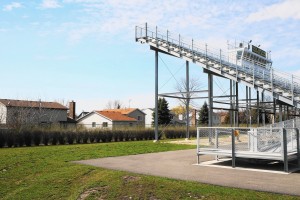Supreme Court rules against CLS bleachers
Gregory Harutunian — September 29, 2015
The Illinois Supreme Court’s decision effectively means the district will have to dismantle the bleachers, completed in 2013, which cost approximately $1.8 million. (Chronicle Media photo)
The Illinois Supreme Court has ruled against Community High School District 155, in erecting expanded bleachers and larger parking facilities at its Crystal Lake South campus. The decision effectively means the district will have to dismantle the structure, completed in 2013, which cost approximately $1.8 million.
The Sept. 24 announcement caught both the district and the city of Crystal Lake off guard, and hastily-worded press releases indicated that both camps were pledging cooperation in light of the determination.
At issue was the bleacher expansion, which occurred without proper permitting or zoning variances, while the top tiers of their east and west sides required a variance for height restrictions currently in effect through the city’s zoning ordinances. The deeper issue was whether a school district can act independently of a municipal, or local governmental, zoning codes.
A press release, attributed to District 155 Board of Education President Ted Wagner, said, in part, “We are disappointed with (the) Illinois Supreme Court ruling … (we) followed the required Illinois School Code process, and obtained all required permits from the Regional County Superintendent in planning and constructing the bleachers at Crystal Lake South High School.
“District 155 will fully comply with all court orders regarding the demolition of the bleachers. At the direction of the Board of Education, in December 2014, the district issued a request for proposals seeking bids for this work demolition. We are committed to working with our residential neighbors, and we will continue to work with the City of Crystal Lake to move forward in a cooperative and respectful manner.”
As the district was left to begin finalizing a demolition process, and a timeline with minimum disruption to the community, the city of Crystal Lake called a press conference that evening, with Mayor Aaron Shepley fielding questions, and responding to the city’s press release.
According to the release: “Those bleachers, which School District 155 constructed without notification to the affected property owners and without going through the City’s zoning process, reportedly cost $1.2 million, and are made of solid sheets of metal extending more than three times in width and almost double the number of rows.”
Shepley’s statements were also contained in the release: “District 155 disdained the city’s requests, and instead dragged the city, the neighbors, and the community into this legal odyssey. And after wasting the money on the bleachers and all the legal fees, what have we learned? That District 155 should have gone through the City’s zoning process.
“Although the Court’s ruling is a powerful victory for everybody’s constitutional property rights, the lesson came at an unnecessary and painfully high price.”
District 155 attorney Rob Swain said, “There will be definite repercussions to the district, regarding the next steps and the demolition. As for the legal costs, it is being paid through the fiduciary insurance claim, and has totaled approximately $300,000. The supreme court representation was done gratis, and on a pro bono basis.”
Michelle Rentzch, the city’s community development director, had said that two tracks were taken last spring including the legal pursuit with the supreme court, following two appellate decisions that alternately concurred with the teardown, and a referral back to the local level.
The Crystal Lake Advisory Board, of the city’s Planning and Zoning Commission, denied a special-use permit for District 155 for expanded bleachers at its athletic field, during its April 13 meeting. The full city council upheld the recommendation May 5, setting the stage for arguments before the high court that lasted one day, and subsequent deliberations with no time window.
“The next step is that the board of education will meet Sept. 30, for a special session, to discuss options, and any further information will come from that meeting,” said Shannon Mortimer, the district’s public information officer. “We are continuing to work with neighbors and the city.”
Attempts to contact Mayor Shepley for comment were not successful, as of press time.
–Supreme Court rules against CLS bleachers–



